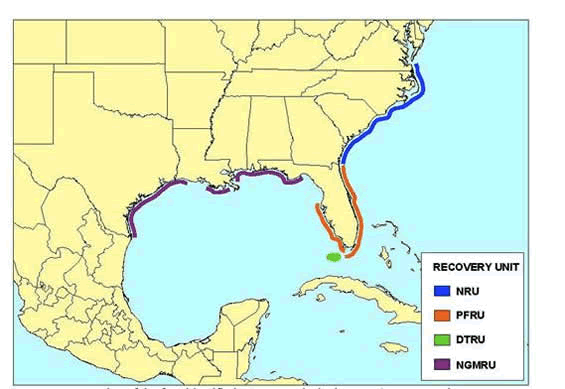Description and Ecology

Loggerheads are a type of sea turtle primarily identified by their large heads, which maintain strong jaws that allow them to eat shelled marine life, such as mollusks and crabs. The tops of their shells are heart shaped and appear to be a mixture of red and brown, while their bottom shell is a pastel yellow. The average adult length of this reptile species is 36 inches, and the average adult weight is 250 pounds. Loggerheads mate in the late spring season, and the females lay eggs in up to five nests over the following months. After two months of incubation, brown to dark gray hatchlings are born in the fall.
Geographic and Population Changes
 |
| http://mgh-images.s3.amazonaws.com/9781938168116/524579-20-2ACQEI1.png |
Although this species is found in the Atlantic, Pacific and Indian Oceans, most of their nesting occurs on the western coasts of the Atlantic and Indian Oceans near the subtropics. Southern Florida is one of two nesting sites which involve over 10,000 nesting females each year, as demonstrated below. Approximately 47,000 to 90,000 nests in the coastal United States have been estimated over the last ten years. Other nesting locations along the Indian Ocean do not have known estimations of population size, and the populations of loggerheads in South America and other coastal areas such as Greece or Japan have been decreasing.
 |
| http://www.registrelep-sararegistry.gc.ca/document/doc2025/ind_e.cfm#_Toc263150044 |
Listing Date and Type of Listing
Dependent on location:
- Endangered, 07/23/1978
- NE Atlantic Ocean, North Indian Ocean, South Pacific Ocean, Mediterranean Sea, North Pacific Ocean
- Threatened, 07/23/1978
- SE Indian Ocean, NW Atlantic Ocean, SW Indian Ocean, South Atlantic Ocean
Causes of Listing and Threats
The main threats to loggerheads include incidental capture via loglines, trawls, and dredges, as well as other general marine life threats. Juvenile loggerheads are specifically more likely to ingest marine debris in the pelagic zone where they reside before maturity. Because loggerheads rely on coastal environments to lay eggs and maintain population growth, numerous issues involving human arise. Increased number of docks interrupts natural shore habitats, and boats increase risk of injury or death from propellers (see image below). Beach cleaning is another culprit of habitat alteration for loggerheads; mechanical raking can increase the mortality rate of hatchlings and females may even abort their nests. Furthermore, beaches along the east coast that allow vehicle driving lead to direct destruction of nests, as well as females or hatchlings to be crushed.Lastly, light pollution can inhibit nesting females from making their way back to the ocean and they might instead move onto nearby roads where they are hit by vehicles. Hatchlings are also more apt to follow lighted areas instead of toward the ocean and die from dehydration or passing cars.
 |
| https://9gag.com/gag/aMGyd16/a-dead-sea-turtle-hit-by-the-propeller-of-a-boat-srsly-do-humans-even-need-to-be-in-this-world |
The Recovery Plan
 |
| http://www.registrelep-sararegistry.gc.ca/document/doc2025/p2_e.cfm#_Toc263150078 |
- the number of nests and nesting females in each area is increasing
- the amount of juveniles in the neritic and oceanic areas are is increasing more than it historically has
- beach habitat will aid successful nesting for females
- scientifically supported nesting regulation plans are put into place
- long term protection of loggerheads is provided at the local, state, Federal, and international levels
- by catch, habitat alteration, marine debris ingestion, and vessel striking is reduced
What can YOU do?
Easy steps you can take to help:
- Reduce the amount of beach fires during nesting season
- Don't leave trash or plastic bags on the beach
- Be aware when boating to avoid collision with loggerheads
- Let others know about the challenges loggerheads face
Other Resources ~ Visit these sites to learn more!
http://seaturtleexploration.com/explore-and-learn/sea-turtle-facts/loggerhead/
Biography
All information was sourced from the Recovery Plan for the Loggerhead Sea Turtle
National Marine Fisheries Service and U.S. Fish and Wildlife Service. 2008. Recovery Plan for the Northwest Atlantic Population of the Loggerhead Sea Turtle (Caretta caretta), Second Revision. National Marine Fisheries Service, Silver Spring, MD.
 |
| http://coolprogeny.com/2016/01/help-name-the-national-aquariums-new-loggerhead/ |
Biography
All information was sourced from the Recovery Plan for the Loggerhead Sea Turtle
National Marine Fisheries Service and U.S. Fish and Wildlife Service. 2008. Recovery Plan for the Northwest Atlantic Population of the Loggerhead Sea Turtle (Caretta caretta), Second Revision. National Marine Fisheries Service, Silver Spring, MD.

It was sad to see just how many dangers the loggerhead sea turtle faces. Hopefully the recovery plan is able to implement the changes necessary to save this species.
ReplyDelete-Marina Enriquez
ReplyDeleteIt's interesting to see the impact humans have on the loggerhead sea turtle. I was shocked to learn that boat propellers can be a huge threat to the species. The photo of the turtle's damaged shell makes me want to help with this species' conservation efforts.
ReplyDelete-Erika DiLeva